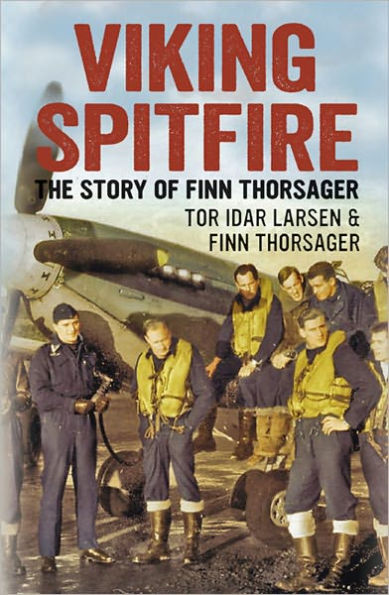Viking Spitfire: The Story of Finn Thorsager
9 April 1940: Finn Thorsager was the first Norwegian to open fire on invading German forces. He was credited with shooting down an enemy aircraft in a Gloster Gladiator biplane that dark morning, and made Norwegian history. Thorsager escaped the Nazi occupation, and fled Norway in the autumn of 1940. He travelled through Sweden, the Soviet Union, Japan, USA, and finally arrived at ‘Little Norway’, a training camp in Canada. After a time as an instructor, Thorsager was transferred to England where he joined 331 Squadron flying Hawker Hurricanes and then sister squadron, 332, in the legendary Supermarine Spitfire.
In 1942, Thorsager was based at North Weald, Essex, where he flew dangerous missions over enemy occupied France and also took part in the infamous raid on Dieppe where the Allies suffered a bloody nose by a superior German defender. It was during this mission that Thorsager engaged several Fw 190s, a fighter that had a distinct edge over the Spitfire in terms of punch and performance. On another such dangerous mission to St Omer, Thorsager and fellow pilots said goodbye to each other as it was considered to be suicidal.
Thorsager became a major and squadron leader in 1943 where he had a one-to-one fight with a Fw 190 over Vlissingen. In 1944, he relocated to St. Andrews, flying as a Lodestar captain on a dangerous civilian route between Scotland and Sweden. He had several close shaves flying the Lockheed L-18 Lodestar transport aircraft, and was also attacked by a deadly Arado 234 jet fighter over Norway. Thorsager survived the war, and stayed in the air as an airline captain until his retirement in 1976.
1112136550
In 1942, Thorsager was based at North Weald, Essex, where he flew dangerous missions over enemy occupied France and also took part in the infamous raid on Dieppe where the Allies suffered a bloody nose by a superior German defender. It was during this mission that Thorsager engaged several Fw 190s, a fighter that had a distinct edge over the Spitfire in terms of punch and performance. On another such dangerous mission to St Omer, Thorsager and fellow pilots said goodbye to each other as it was considered to be suicidal.
Thorsager became a major and squadron leader in 1943 where he had a one-to-one fight with a Fw 190 over Vlissingen. In 1944, he relocated to St. Andrews, flying as a Lodestar captain on a dangerous civilian route between Scotland and Sweden. He had several close shaves flying the Lockheed L-18 Lodestar transport aircraft, and was also attacked by a deadly Arado 234 jet fighter over Norway. Thorsager survived the war, and stayed in the air as an airline captain until his retirement in 1976.
Viking Spitfire: The Story of Finn Thorsager
9 April 1940: Finn Thorsager was the first Norwegian to open fire on invading German forces. He was credited with shooting down an enemy aircraft in a Gloster Gladiator biplane that dark morning, and made Norwegian history. Thorsager escaped the Nazi occupation, and fled Norway in the autumn of 1940. He travelled through Sweden, the Soviet Union, Japan, USA, and finally arrived at ‘Little Norway’, a training camp in Canada. After a time as an instructor, Thorsager was transferred to England where he joined 331 Squadron flying Hawker Hurricanes and then sister squadron, 332, in the legendary Supermarine Spitfire.
In 1942, Thorsager was based at North Weald, Essex, where he flew dangerous missions over enemy occupied France and also took part in the infamous raid on Dieppe where the Allies suffered a bloody nose by a superior German defender. It was during this mission that Thorsager engaged several Fw 190s, a fighter that had a distinct edge over the Spitfire in terms of punch and performance. On another such dangerous mission to St Omer, Thorsager and fellow pilots said goodbye to each other as it was considered to be suicidal.
Thorsager became a major and squadron leader in 1943 where he had a one-to-one fight with a Fw 190 over Vlissingen. In 1944, he relocated to St. Andrews, flying as a Lodestar captain on a dangerous civilian route between Scotland and Sweden. He had several close shaves flying the Lockheed L-18 Lodestar transport aircraft, and was also attacked by a deadly Arado 234 jet fighter over Norway. Thorsager survived the war, and stayed in the air as an airline captain until his retirement in 1976.
In 1942, Thorsager was based at North Weald, Essex, where he flew dangerous missions over enemy occupied France and also took part in the infamous raid on Dieppe where the Allies suffered a bloody nose by a superior German defender. It was during this mission that Thorsager engaged several Fw 190s, a fighter that had a distinct edge over the Spitfire in terms of punch and performance. On another such dangerous mission to St Omer, Thorsager and fellow pilots said goodbye to each other as it was considered to be suicidal.
Thorsager became a major and squadron leader in 1943 where he had a one-to-one fight with a Fw 190 over Vlissingen. In 1944, he relocated to St. Andrews, flying as a Lodestar captain on a dangerous civilian route between Scotland and Sweden. He had several close shaves flying the Lockheed L-18 Lodestar transport aircraft, and was also attacked by a deadly Arado 234 jet fighter over Norway. Thorsager survived the war, and stayed in the air as an airline captain until his retirement in 1976.
9.99
In Stock
5
1

Viking Spitfire: The Story of Finn Thorsager
208
Viking Spitfire: The Story of Finn Thorsager
208
9.99
In Stock

Product Details
| BN ID: | 2940014942850 |
|---|---|
| Publisher: | Fonthill Media LLC |
| Publication date: | 07/16/2012 |
| Sold by: | Barnes & Noble |
| Format: | eBook |
| Pages: | 208 |
| File size: | 8 MB |
About the Author
From the B&N Reads Blog
